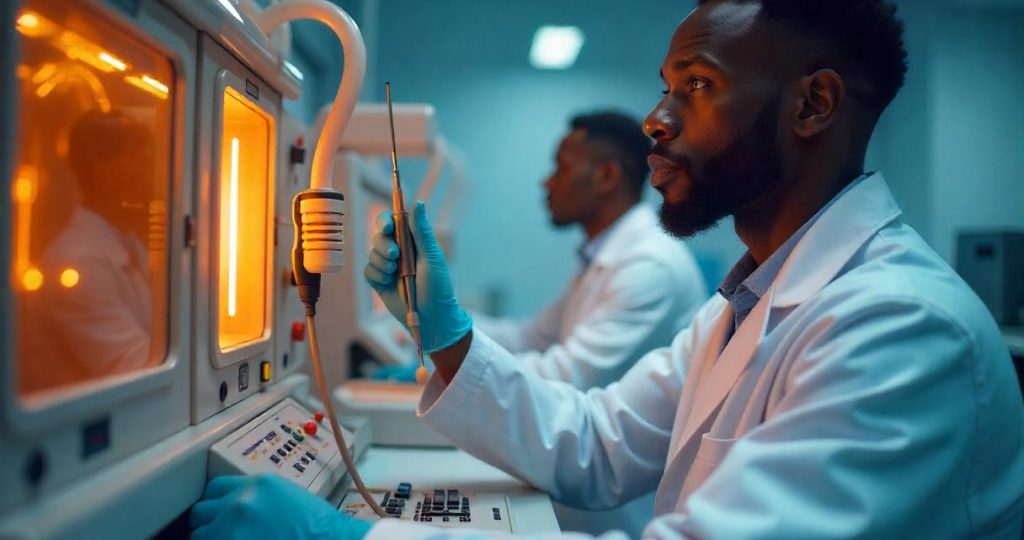Medically Written and Reviewed By Pavan Reddy (Biomedical Engineer)

Introduction: Roche’s New AI Tool
In an exciting step forward for cancer diagnosis, the U.S. Food and Drug Administration (FDA) have given Breakthrough Device Designation to a new tool developed by Roche. The tool is called the VENTANA TROP2 assay, and it uses artificial intelligence (AI) to detect and treatment stratification of lung cancer known as non-small cell lung cancer (NSCLC).
NSCLC is the most common form of lung cancer, making up about 85% of all lung cancer cases around the world. Roche’s test doesn’t just find cancer. It also helps to figure out the best treatment options for each patient by analyzing how the cancer behaves. This new AI-driven approach could lead to faster, more accurate diagnoses, and more personalized treatment plans, giving patients a better chance of successful treatment.
What Is TROP2 and Why Does It Matter?
TROP2 is a special kind of protein found on the surface of certain cells, including many cancer cells. It’s especially common in epithelial cancers, like non-small cell lung cancer (NSCLC). When a tumor has high levels of TROP2, it usually means the cancer is growing quickly and may lead to a poorer outcome for the patient. Because of this, TROP2 is considered an important biomarker a signal can use to better understand the cancer and choose the right treatment.
Unlike older companion diagnostic tests that only look at protein levels on the surface of cancer cells Roche’s VENTANA TROP2 assay uses artificial intelligence (AI) to measure exactly how much TROP2 is also present inside a tumor sample. This helps oncologists get very precise information about the cancer, which can guide them in choosing more targeted, effective therapies for each patient.
How the AI Tool Works: Powered by Digital Pathology
Roche’s VENTANA TROP2 (EPR20043) RxDx device is an immunohistochemistry (IHC) assay is part of a larger digital system called uPath, which is the company’s digital pathology platform. This platform is designed to look at complex tissue samples more easily and accurately.
By using advanced AI algorithms based image analysis with a level of diagnostic precision; uPath can analyze cancer cells more quickly and consistently than traditional methods. It reduces the chance of human error and helps ensure that results are reliable and repeatable. This means pathologists can make faster, more confident decisions about a patient’s diagnosis.
Implications for Personalized Medicine
The FDA’s Breakthrough Device Designation highlights the significant potential of Roche’s VENTANA TROP2 assay to enhance clinical outcomes for patients. This designation recognizes the assay’s ability to support more personalized and targeted treatment strategies, particularly for individuals with TROP2-positive cancers.
By accurately identifying patients who are most likely to respond to TROP2-targeted therapies, the assay enables oncologists to select the most effective treatment options from the outset. This can lead to higher response rates, improved survival outcomes, and a more efficient use of therapies in clinical practice.
Looking Ahead: Shaping the Future of Lung Cancer Diagnosis
As the VENTANA TROP2 assay continues through clinical validation and regulatory review, it shows strong potential to transform how non-small cell lung cancer (NSCLC) is diagnosed and treated. By offering more precise insights into tumor biology, the assay could become a powerful tool in guiding personalized cancer care.
This advancement also reinforces the growing importance of precision medicine an approach that tailors treatment to each patient’s unique disease profile. If successful, this assay could help set a new standard in how lung cancer is diagnosed and managed, leading to better outcomes for patients.
Reference
1. Roche granted FDA Breakthrough Device Designation for first AI-driven companion diagnostic for non-small cell lung cancer, 29 April 2025, Roche Diagnostic
2. Mito R, et al. Clinical impact of TROP2 in non‐small lung cancers and its correlation with abnormal p53 nuclear accumulation.Pathol Int. 2020;70(5):287-294.
3. Shvartsur A, et al. Trop2 and it’s over expression in cancers: regulation and clinical/therapeutic implications. Genes & Cancer. 2015 Mar; 6(3-4): 84-105.
4. Roche receives FDA breakthrough label for AI-powered lung cancer companion diagnostic test, 29 April 2025, fierce biotech, available from https://www.fiercebiotech.com/medtech/roche-receives-fda-breakthrough-label-ai-powered-lung-cancer-companion-diagnostic-test


Add a Comment